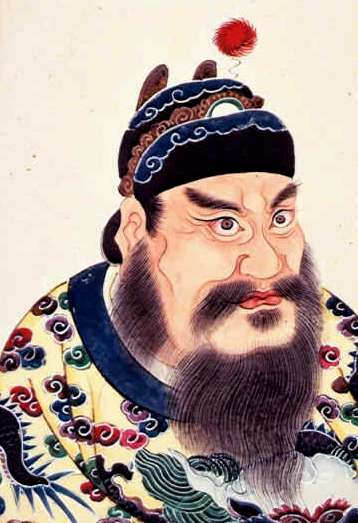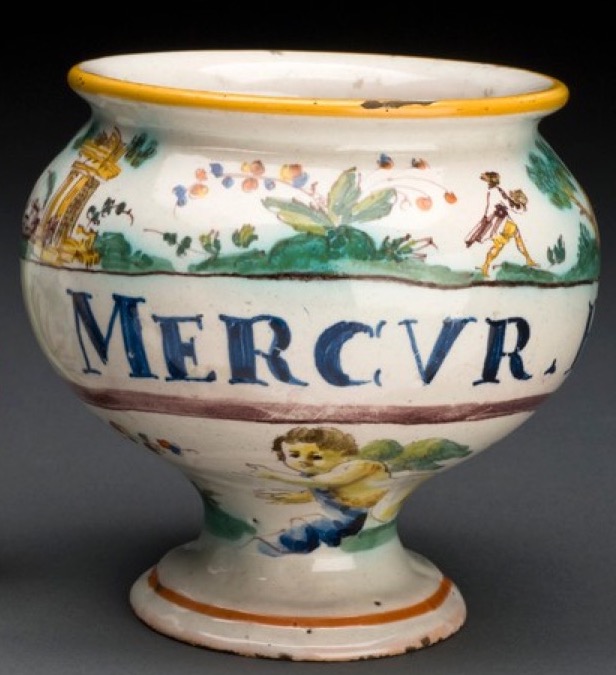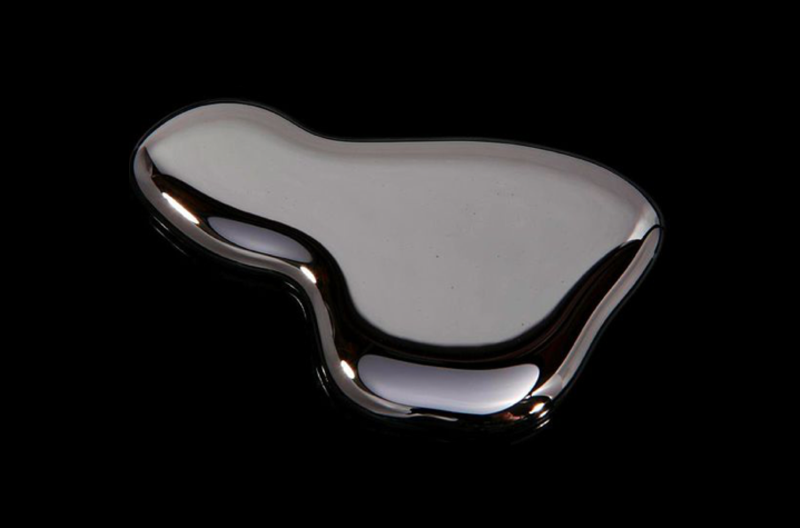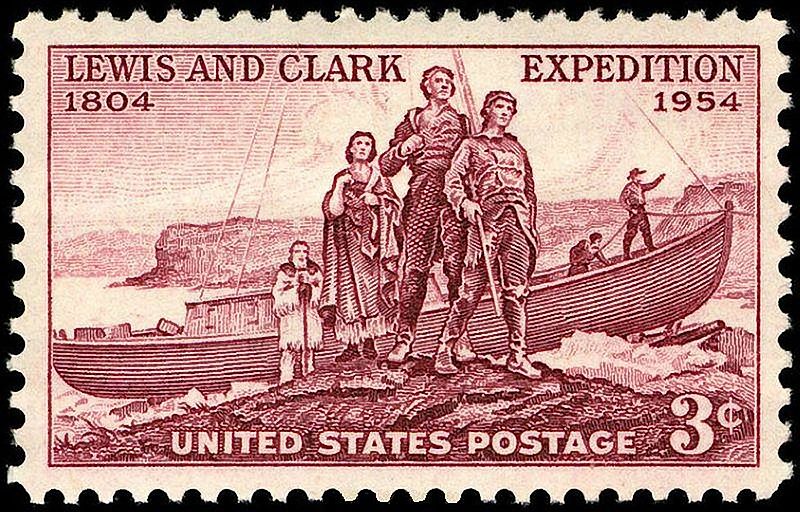The Origin Of The Word ‘Mercury’
From ancient alchemists to Lewis and Clark, mercury has a storied history.
 Science Diction is a bite-sized podcast about words—and the science stories behind them. Subscribe wherever you get your podcasts, and sign up for our newsletter.
Science Diction is a bite-sized podcast about words—and the science stories behind them. Subscribe wherever you get your podcasts, and sign up for our newsletter.
Mercury has several claims to fame: It’s the only metallic element that’s liquid at room temperature, it’s been known to ancient cultures for centuries upon centuries.
Buried deep under a mound of earth in the Shaanxi province in China sits a tomb the size of a soccer field. Writings describe an otherworldly sight that hasn’t been seen since the third century BCE: Constellations mapped in jewels across the ceiling, towering replicas of palaces, crossbows and arrows poised in a booby-trap in case of intruders, and shimmering rivers of silvery liquid mercury imitating the paths of the Huang He and the Yangtze rivers.

The underground mausoleum was constructed for Qin Shi Huang, the first emperor of unified China. And while the details of these these fantastical descriptions may be exaggerated, researchers did discover heightened levels of mercury in the soil surrounding the mausoleum in the 1980s, and the tomb remains sealed both to avoid air and water damage, and, as author and physician Lydia Kang put it, to contain the potential “toxic bomb” of mercury inside. The emperor was obsessed with finding the elixir of life—and he believed mercury held the key. He faithfully downed mixtures of the shining element, and he died of mercury poisoning at the age of 49, according to Quackery by Kang and Nate Pedersen.
“The fascination with this element and the fascination with searching for health and longevity at the detriment to your own health and longevity—it’s sadly ironic,” says Kang in a call to Science Friday.
The emperor wasn’t the only one who harbored that fascination. Traces of the element in Egypt date to 1500 BCE, and for centuries, mercury was at the center of both alchemy and medicine. Beliefs among alchemists differed across the world, but mercury consistently played a key role in the practice. Alchemists often referred to the mysterious substance as “quicksilver.” Quickness and agility were characteristics of the Roman god Mercury, and they used his namesake planet—the fastest moving planet in our solar system—to symbolize the element. Today, the element is officially known as mercury on the periodic table, but it retains its Hg abbreviation—a nod to its old Latin name, hydrargyrum, which means “water silver.”

Even beyond the days of alchemy, there was still confusion about what the strange silver could and couldn’t do. For centuries, mercury-containing pills were the cure du jour for ailments ranging from syphilis to constipation to yellow fever, write Kang and Pedersen in Quackery. The pills induced swift bowel and stomach movements, and—in a nod to humoral theory—were intended to flush out whatever toxin was ailing you.
“Everything was like, ‘You don’t feel well? Take some purging pills. And if you have constipation, take some purging pills. And if you have a bad appetite, take some purging pills,’” says Kang.
“And it’s laughable, but it also speaks to how that was the go-to medication of the time.”
One proponent of this “cure” was none other than Dr. Benjamin Rush, one of the signatories of the Declaration of Independence. Rush advocated for the purging powers of mercury-based medicines through the yellow fever epidemic in Philadelphia in the late 1700s, and prescribed copious doses of the pills left and right. It was later found that his patients had a more than 10 percent higher fatality rate than other yellow fever patients. On top of dealing with the other effects of yellow fever, Rush’s patients were constantly purging their bodies of fluids.
There’s a difference between organic mercury, like quicksilver and liquid mercury (which is rumored to flow through Qin Shi Huang’s tomb), and mercury salts, which were found in the mercury-based medicines that Rush and others prescribed. Inorganic mercury like the salts tend to be processed via the kidneys, and the effects, while unpleasant, generally wash out of our system, says Kang. Organic mercury is another story—toxicity levels are much higher, and can result in permanent neurological damage or even death.

When a certain “cure” has been around for centuries, says Kang, it’s tough to let go of it. Part of the appeal of mercury was that at least it was doing something.
“You take it, it’s doing something, you go to the bathroom, [and then] generally when you have a stomachache, if it’s not food poisoning or something quite deadly, it goes away after a couple days,” she says. “So that causality is there. People say, ‘I took this and then I got better,’ not teasing out that if you really test it you’ll find that actually it might’ve gone away on its own or that wasn’t the actual cure.”
While mercury as a medical cure is certainly questionable, the element recently provided a pivotal role in the science of pinpointing a key campsite location in the Lewis and Clark expedition.
In 1804, after a failed attempt to find the “fabled” Northwest Passage, Meriwether Lewis and William Clark stopped to rest for two days. They would call the camp Traveller’s Rest, and it’s the same site where the Corps split into two groups on their return trip in 1806, in order to explore more of the continent. But for centuries, no one knew the precise location of Traveller’s Rest.
Thanks largely to Lewis and Clark’s meticulous diary entries, researchers had a rough idea of the camp’s location, in western Montana. But in the end, the evidence that helped seal the deal was mercury traces located almost exactly 300 feet from the proposed location of the campsite… which brings us back to Dr. Benjamin Rush.
Before setting off on their expedition, Rush supplied Lewis and Clark with no fewer than 50 dozen of his pills known as “thunderclappers,” which were meant to serve as an antidote to any number of ailments the Corps may encounter on their journey. The pills were a blend of chlorine, the herbal laxative jalap, and a whopping 60 percent mercury—and based on the name, you may be able to guess the bodily outcome of popping Rush’s “thunderclaps.”

The Corps of Discovery followed the rules outlined in the U.S. army’s “Blue Book,” which detailed proper campsite layout: Among other regulations, the latrines should be 300 feet from the campsite.
Centuries later, when researchers employed mercury vaporizer analysis near the proposed Traveller’s Rest location, guess how far away from the campsite the mercury traces appeared. Because mercury forms strong bonds with sulfur, which is located in organic soils like the ones at Traveller’s Rest, it’s unlikely that the mercury deposits would’ve moved away from the latrine’s original location over the years.
And while mercury use for medicinal purposes may not be common today, it still gives us a (potentially toxic) peek into our past.
Editor’s Note: A previous version of this article stated that mercury was the only element to share its common name with a Roman god. This is incorrect, as both Neptunium and Plutonium share their names with Roman gods as well.
Johanna Mayer is a podcast producer and hosted Science Diction from Science Friday. When she’s not working, she’s probably baking a fruit pie. Cherry’s her specialty, but she whips up a mean rhubarb streusel as well.